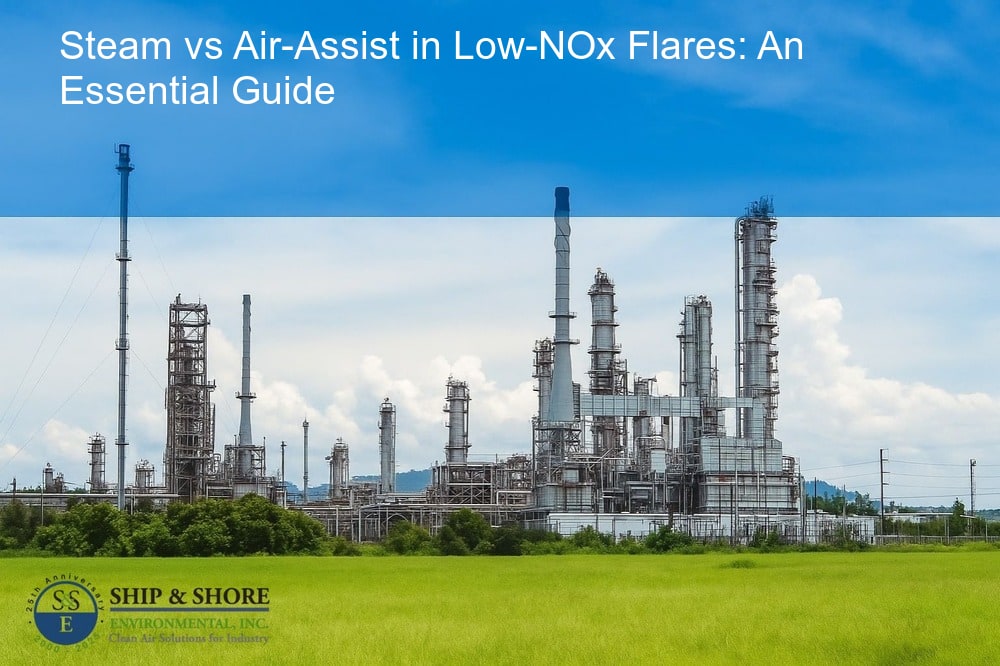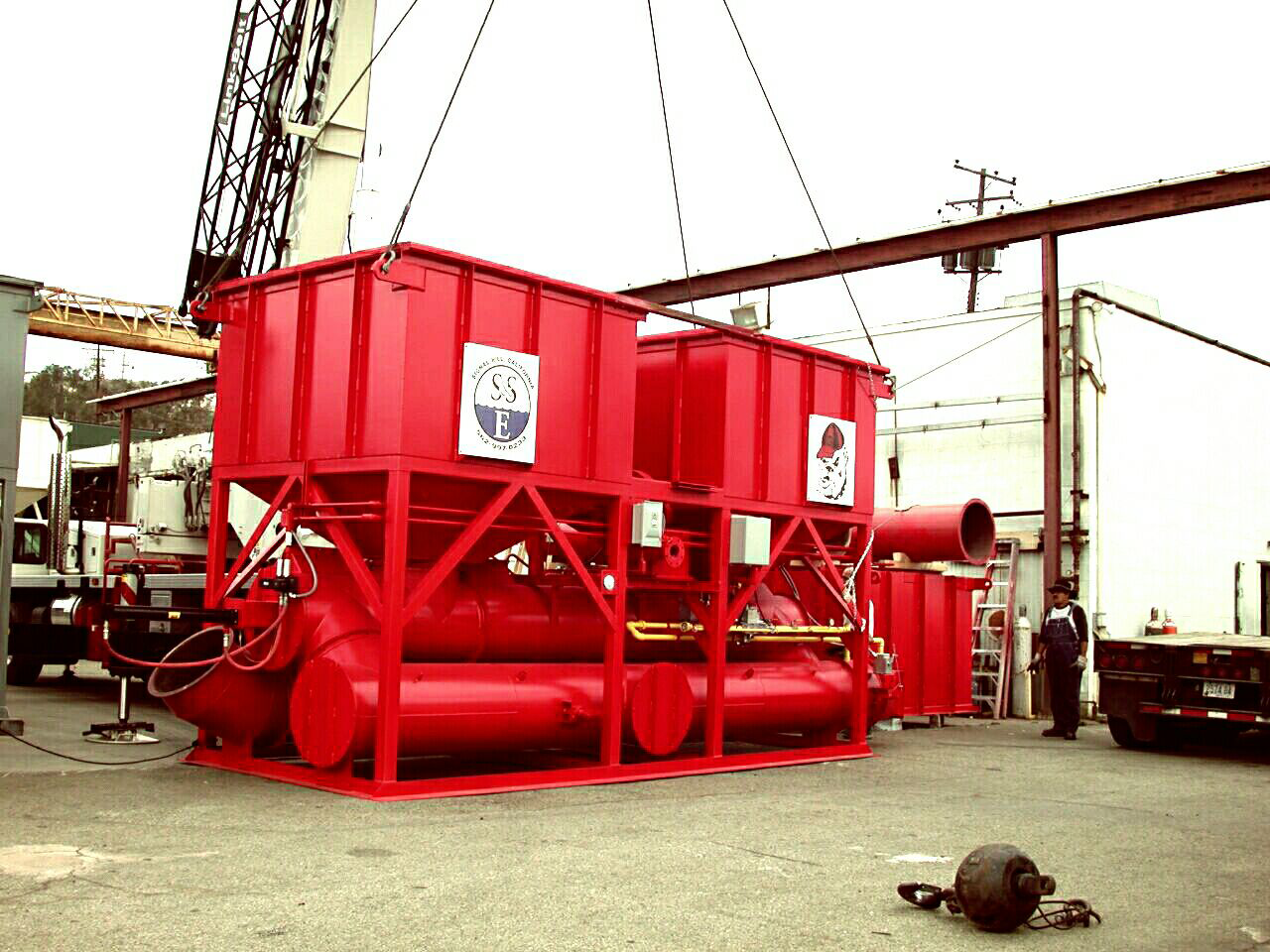
Steam vs Air-Assist in Low-NOx Flares: A Thorough Comparison
September 3, 2025 5:17 amUnderstanding the Basics of Low-NOx Flares
In the quest for reducing harmful emissions, one pivotal consideration becomes evident: the choice between steam- vs air-assist in low-NOx flares. Low-NOx (nitrogen oxides) flares play a critical role in minimizing environmental impact by ensuring that flaring processes release fewer pollutants into the atmosphere. To achieve this, it is essential to understand the core principles of low-NOx flares and the mechanisms behind them.
Low-NOx flares are designed to combust waste gases efficiently, mitigating the release of NOx, a group of highly reactive gases that contribute to air pollution and can have severe health and environmental effects. By lowering the formation of NOx emissions, these systems significantly contribute to cleaner air and improved public health.
The Differences Between Steam- and Air-Assist Systems
When it comes to aiding the combustion process in low-NOx flares, two primary methods stand out: steam-assist and air-assist systems. Although both are aimed at optimizing combustion and reducing emissions, the mechanisms by which they achieve these goals differ significantly.
Steam-assist systems utilize steam injection to enhance the flare’s efficiency. By injecting steam, these systems provide the necessary turbulence and oxygen to promote complete combustion and reduce the formation of black smoke and NOx emissions. Steam-assist flares are particularly useful in situations where waste gas streams are rich in hydrocarbons.
On the other hand, air-assist systems employ air to achieve similar outcomes. Forced air is directed into the flare stream to facilitate thorough mixing of the gases and complete combustion. Air-assist systems are renowned for their flexibility and the ability to maintain proper combustion in varying waste gas compositions.
Importance of Choosing the Right System
Selecting the appropriate assist system for low-NOx flares is not just a technical decision; it also embodies an organization’s commitment to environmental responsibility. The choice between steam- and air-assist systems can influence several factors including operational costs, flare efficiency, and overall environmental impact.
A thorough understanding of the differences between these systems and their respective advantages and drawbacks is essential for making an informed decision. Choosing the right system ensures compliance with stringent environmental regulations and can significantly enhance the sustainability of operations.
In-Depth Look at Steam-Assist in Low-NOx Flares
Functioning
Steam-assist systems operate by injecting steam into the flare tip, where it mixes with the waste gas. This mixing process enhances combustion efficiency, helping to reduce the formation of NOx emissions. The addition of steam also helps to achieve smokeless burning by promoting more complete oxidation of hydrocarbons. As the steam and gas mix, the temperature is lowered, leading to fewer NOx emissions.
Advantages
One of the primary advantages of steam-assist systems is their ability to significantly reduce NOx emissions. The injection of steam promotes a more complete combustion process, which results in fewer pollutants being released into the atmosphere. Additionally, steam-assist flares tend to operate more quietly compared to other systems. They are particularly effective when dealing with certain types of waste gases, making them a versatile option for various industrial applications.
Potential Drawbacks
However, steam-assist systems are not without their drawbacks. One potential issue is the need for a reliable source of steam. Without a consistent supply, the system cannot function as efficiently, leading to increased emissions. Furthermore, steam production and supply can be resource-intensive, adding to operational costs. Maintenance of steam lines and injectors also requires regular attention to ensure optimal performance.
Examining Air-Assist in Low-NOx Flares
Operation Principle
Air-assist systems function by injecting air into the flare tip, enhancing the mixing of air and waste gases. This improved mixing leads to a more complete combustion process, reducing the formation of NOx emissions. The air is typically supplied by a blower or compressor, ensuring a consistent and controlled flow. Like steam-assist systems, air-assist flares aim to achieve smokeless combustion by improving the oxidation of hydrocarbons.
Benefits
Air-assist systems offer several advantages, including lower operational costs compared to steam-assist systems. Since the primary requirement is air, which is abundantly available, there are fewer dependencies on external resources. Additionally, air-assist flares can be more straightforward to maintain, as they do not involve complex steam generation and delivery systems. These systems are often considered more reliable and easier to operate in various industrial settings.
Possible Limitations
Despite the benefits, air-assist systems have limitations. They can be noisier due to the use of blowers or compressors, which may not be suitable for noise-sensitive environments. Moreover, while they effectively reduce NOx emissions, they may not achieve the same level of reduction as steam-assist systems in certain applications. The selection of blowers and compressors must be done carefully to ensure compatibility with the specific waste gases being managed.
Comparative Analysis of Steam- vs Air-Assist in Low-NOx Flares
When comparing steam- vs air-assist in low-NOx flares, several factors must be considered to determine the best choice for a specific application. Each system offers unique benefits and faces distinct challenges.
- Efficiency: Steam-assist systems generally provide higher NOx reduction efficiency due to enhanced mixing and cooling effects.
- Cost: Air-assist systems often have lower operational costs, as they do not require an external steam supply.
- Maintenance: Steam-assist systems may demand more intensive maintenance due to steam line upkeep, whereas air-assist systems require less complex maintenance.
- Noise: Air-assist systems can be noisier, which might be a concern in certain industrial settings requiring quieter operations.
- Versatility: Both systems are versatile, but the choice depends on the specific type of waste gases and the operational environment.
Did you know that Low-NOx flares with steam assist can reduce nitrogen oxide emissions more effectively than traditional flaring methods, but may require more maintenance due to scaling and corrosion?
Recap: Key Points in the Comparison Between Steam and Air-Assist in Low-NOx Flares
Understanding the nuances between steam- and air-assist systems in low NOx flares is crucial for making informed decisions. Steam-assist systems primarily function by injecting steam into the flame to enhance combustion efficiency. They are effective at reducing soot and other pollutants but come with the downside of requiring a significant steam supply, which can be costly and energy-intensive. On the other hand, air-assist systems utilize forced air to achieve the same goal. They often offer more flexibility in terms of operations and can be more cost-effective, especially in settings with limited water resources. However, they also come with their challenges, such as potential noise issues and limitations in extremely cold environments.
Making an Informed Decision: Factors to Consider When Choosing Between Steam- and Air-Assist
When it comes to selecting between steam- vs air-assist in low-NOx flares, several factors come into play. Cost considerations are paramount, both in terms of initial setup and ongoing operational expenses. For facilities with abundant and inexpensive steam, steam-assist may be the ideal choice. Conversely, air-assist systems might be more suitable for operations lacking a reliable steam supply. Environmental conditions also play a critical role; air-assist systems may struggle in extremely cold settings, whereas steam-assist systems can be more versatile.
Maintenance requirements and operational complexity should not be overlooked. Steam-assist flares can require more frequent maintenance to manage steam supply and quality issues. Air-assist systems, while generally simpler in terms of mechanical complexity, can present challenges related to blower maintenance and noise control. Therefore, it’s essential to thoroughly assess the specific needs and constraints of your facility before making a decision.
Future Trends: Prospects for Steam and Air-Assist in Low-NOx Flares
The landscape for steam- vs air-assist in low-NOx flares continues to evolve with advancements in technology and increasing environmental regulations. Innovations aimed at improving the efficiency and reducing the environmental footprint of both systems are already underway. Manufacturers and policymakers are exploring hybrid systems that leverage the strengths of both steam- and air-assist methods, potentially offering a balanced solution for a wider range of applications. As these technologies advance, we can anticipate even more efficient and cost-effective solutions for controlling emissions in flaring operations.
In conclusion, the choice between steam- and air-assist systems in low NOx flares is multi-faceted, requiring a careful evaluation of cost, environmental conditions, and operational complexities. By keeping abreast of the latest technological advancements and understanding the specific demands of your facility, we can ensure that our flaring operations are not only compliant with environmental regulations but also optimized for efficiency and cost-effectiveness. Visit our low NOx flares page for more detailed information on how our solutions can meet your specific needs.
FAQ
What are the main factors to consider when choosing between steam- and air-assist systems for low-NOx flares?
When selecting the best flare assist technology for low-NOx applications, consider the cost implications, both in terms of initial investment and ongoing operations. Additionally, assess the environmental conditions, such as the availability of water for steam generation or the ambient temperatures that could affect air-assist performance. The complexity of operation, the maintenance required for each system, and any regulatory requirements specific to your area also play critical roles in the decision-making process.
How do steam-assist and air-assist systems in low-NOx flares differ in their functionality?
Steam-assist systems function by injecting steam into the flare to promote thorough combustion, thereby reducing emissions. Conversely, air-assist systems utilize forced air to achieve a similar result. Furthermore, steam-assist systems offer exceptional performance in various environmental conditions but require a consistent supply of steam. On the other hand, air-assist systems can be simpler to operate and maintain, particularly where steam generation is not viable or is more expensive.
What are the advantages of using steam-assist systems in low-NOx flare applications?
Steam-assist systems provide excellent soot and particulate control, which is vital for meeting stringent environmental regulations. They can operate over a wide range of conditions and are proven to be reliable in reducing NOx emissions. Moreover, since steam is generated from water, a steam-assist system may also offer benefits in settings where water is readily available and the use of steam can be optimized as part of the facility’s overall process efficiency.
Can air-assist systems be used effectively in extremely cold environments?
Air-assist systems can face challenges in extremely cold environments due to the potential for air intake freezing or reduced performance. However, they can still be effective if incorporated with design considerations tailored to cold climates, such as pre-heated air systems or freeze protection measures. These adaptations help ensure consistent operations despite harsh temperature conditions.
What future trends can be expected in the development of low-NOx flare technologies?
As environmental regulations continue to tighten, there is an ongoing trend toward the development of more efficient and eco-friendlier low-NOx flare technologies. Hybrid systems that combine the strengths of both steam- and air-assist methods are being explored, potentially providing balanced solutions appropriate for a variety of scenarios. Furthermore, technological innovation is likely to focus on enhancing performance while reducing the carbon footprint and operational costs of these systems. By staying informed about these advancements, we can anticipate integrating more sustainable flaring solutions into our facility operations.
Categorised in: Blog

